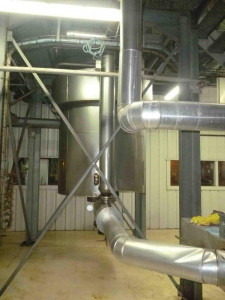A fire broke out in a hazardous waste treatment facility, at around 8:30 a.m. on a holiday, in a workshop where transformers containing PCBs were being processed. The fire was located in a vacuum distillation column used to regenerate perchloroethylene, a chlorinated solvent, which was previously used to clean the inside of transformers containing PCBs. The shift manager on duty, having noticed abnormal smoke and odours, raised the alarm. The fire brigade wanted to drain the heat transfer fluid from the column’s heating system into the dump tank. As the tank was full, an external company had to be called in to pump out the contents before draining the system.
Firefighters injected foam into the column to inert the distillation units present and release the smoke. This operation significantly lowered the temperature of the column (30 °C). At about 4:30 p.m., after inerting the column using a vacuum process, a new hot spot (177 °C), with emissions from the top of the column, were detected. Inerting with nitrogen proved useful. The condition was maintained for the next 3 days. The column remained under surveillance until it had cooled down completely. The heat transfer fluid was completely drained.
The internal contingency plan was not initiated despite the request for intervention by the fire brigade.
Consequences
The high smoke ceiling remained confined in the upper part of the building. The vapours and fumes released by the column were collected by the workshop’s suction system and treated by the activated carbon filter. These filters were changed after the accident, thereby taking into account their possible saturation and avoiding any desorption phenomenon. The measurements taken by the firemen showed that tetrachloroethylene, chlorobenzenes and chlorobiphenyl were present in the workshop air at the time of the event. However, the presence of dioxin could not be confirmed or disproved. The extinguishing water was confined.
First measures
Before restarting, the operator:
- installed a mobile nitrogen inerting system in the workshop to be able to intervene quickly in the event of accidental overheating of the column;
- checked the tightness of the heat transfer fluid circuit and the entire distillation column.
The following analyses were conducted:
- the composition of the recovered distillation residues. Previous analyses had revealed that 88% of the residues were composed of hydrocarbons, as well as chlorobenzenes, PCBs and, to a lesser extent, perchloroethylene;
- the heat transfer fluid collected in the dump tank to check for any contaminants;
- soil samples were taken around the site to ensure that no release of PCBs and dioxins had occurred.
Causal analysis and measures taken
At the time of the event, the column was shut down for a maintenance operation scheduled to take place a few days later. It was empty of liquid.
The most likely cause of the fire was an exothermic reaction of the residues present in the column with the oxygen in the air. The temperature of the residues recovered in IBCs following the accident, and once the column had been cleaned, was quite high.
The inspection authorities for classified facilities required the operator to:
- investigate the nature of the chemical reaction;
- implement measures to prevent such an exothermic reaction from occurring in the distillation residue recovery tank;
- study the possibility of installing a fixed nitrogen inerting system;
- explain why the internal contingency plan had not been initiated.




